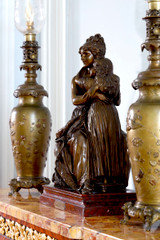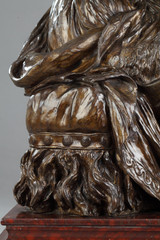A bronze group with a brown patina, after the self-portrait with her daughter Jeanne-Lucie-Louise, known as Julie, created by Elisabeth Vigée Le Brun in 1789 and held at the Louvre Museum . It rests on a stepped red marble base. Titled on the base. 19th century. Circa 1850.
In 1786, Elisabeth Vigée Le Brun painted a self-portrait with her daughter, which was exhibited at the Salon of 1787. The painting so deeply moved the public with the truthfulness of the emotions depicted that it was quickly nicknamed "Maternal Tenderness." Following this success, and at the request of the Count d'Angiviller, Director General of the King's Buildings, the artist painted an equally renowned version in 1789, depicting the mother in Greek costume. These two portraits made such an impact in their time because they crystallized the shift then taking place in attitudes regarding the role of the mother and the concept of maternal love. Since the mid-18th century, there had been a global fascination with all things related to "Nature": unprecedented development of the natural sciences, and an interest in the lives of the "primitive" populations discovered during voyages of exploration around the globe. The expressiveness of feelings that had previously been deliberately concealed became part of this general movement. In society, in art as in literature, emotion, particularly in its sentimental form, plays a major role. This highly cultural construction of Nature has consequences for the perception of maternal feeling, now considered "instinctive." The mother and the love that binds her to her child are glorified by society. The tenderly entwined poses in Vigée Le Brun's portraits with her daughter embody the dual feeling of love and protection of the mother for her child. A recurring model in her mother's paintings, Julie is captured perfectly in the spontaneity of her childlike gestures, turned with an impression of slight surprise in the first painting, and of charming gaiety in the second. The 1789 painting that served as the model for our bronze, "Madame Vigée-Lebrun and her daughter, Jeanne-Lucie-Louise, known as Julie," is held at the Louvre Museum in Paris.
Condition report : very good condition.
Delivery
Europe: €0
US/Canada/HK: €0
Rest of the world: Price upon request
- Reference :
- 2196
- Availability :
- Item available
- Width :
- 35 (cm)
- Height :
- 56 (cm)
- Depth :
- 21 (cm)
- Era:
- 19th century
- Style:
- Rococo
- Materials:
- Patinated bronze, red marble
- Identifier Exists:
- False











































